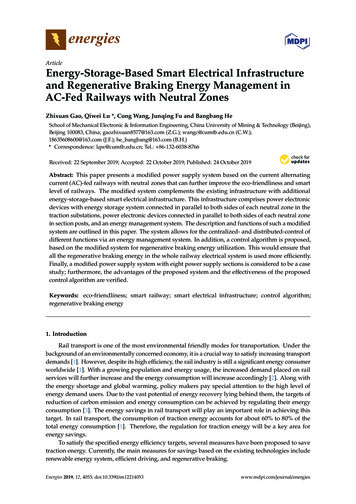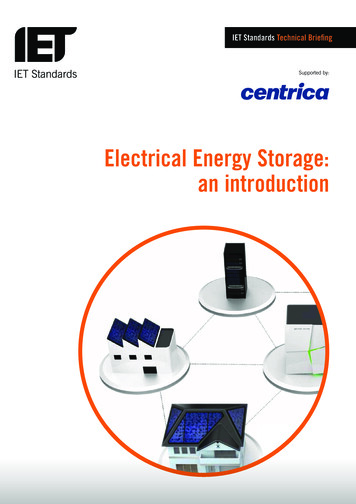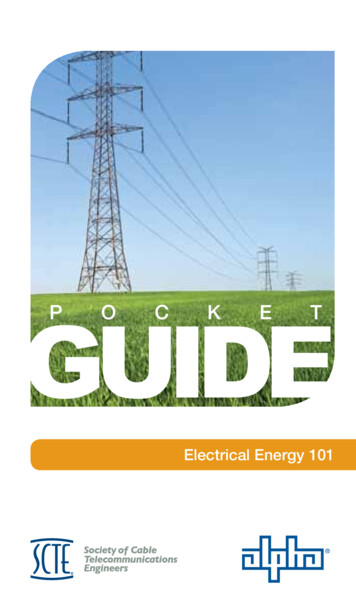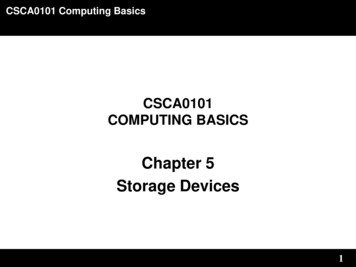
Transcription
energiesArticleEnergy-Storage-Based Smart Electrical Infrastructureand Regenerative Braking Energy Management inAC-Fed Railways with Neutral ZonesZhixuan Gao, Qiwei Lu *, Cong Wang, Junqing Fu and Bangbang HeSchool of Mechanical Electronic & Information Engineering, China University of Mining & Technology (Beijing),Beijing 100083, China; gaozhixuan8577@163.com (Z.G.); wangc@cumtb.edu.cn (C.W.);18635608600@163.com (J.F.); he bangbang@163.com (B.H.)* Correspondence: lqw@cumtb.edu.cn; Tel.: 86-132-6038-8766Received: 22 September 2019; Accepted: 22 October 2019; Published: 24 October 2019 Abstract: This paper presents a modified power supply system based on the current alternatingcurrent (AC)-fed railways with neutral zones that can further improve the eco-friendliness and smartlevel of railways. The modified system complements the existing infrastructure with additionalenergy-storage-based smart electrical infrastructure. This infrastructure comprises power electronicdevices with energy storage system connected in parallel to both sides of each neutral zone in thetraction substations, power electronic devices connected in parallel to both sides of each neutral zonein section posts, and an energy management system. The description and functions of such a modifiedsystem are outlined in this paper. The system allows for the centralized- and distributed-control ofdifferent functions via an energy management system. In addition, a control algorithm is proposed,based on the modified system for regenerative braking energy utilization. This would ensure thatall the regenerative braking energy in the whole railway electrical system is used more efficiently.Finally, a modified power supply system with eight power supply sections is considered to be a casestudy; furthermore, the advantages of the proposed system and the effectiveness of the proposedcontrol algorithm are verified.Keywords: eco-friendliness; smart railway; smart electrical infrastructure; control algorithm;regenerative braking energy1. IntroductionRail transport is one of the most environmental friendly modes for transportation. Under thebackground of an environmentally concerned economy, it is a crucial way to satisfy increasing transportdemands [1]. However, despite its high efficiency, the rail industry is still a significant energy consumerworldwide [1]. With a growing population and energy usage, the increased demand placed on railservices will further increase and the energy consumption will increase accordingly [2]. Along withthe energy shortage and global warming, policy makers pay special attention to the high level ofenergy demand users. Due to the vast potential of energy recovery lying behind them, the targets ofreduction of carbon emission and energy consumption can be achieved by regulating their energyconsumption [3]. The energy savings in rail transport will play an important role in achieving thistarget. In rail transport, the consumption of traction energy accounts for about 60% to 80% of thetotal energy consumption [1]. Therefore, the regulation for traction energy will be a key area forenergy savings.To satisfy the specified energy efficiency targets, several measures have been proposed to savetraction energy. Currently, the main measures for savings based on the existing technologies includerenewable energy system, efficient driving, and regenerative braking.Energies 2019, 12, 4053; s
Energies 2019, 12, 40532 of 24The installation of equipment that provide clean energy from renewable sources (e.g., solar panelsand wind generators) to feed the traction loads in rail may have a significant impact in the energy costsand CO2 emissions of a railway system, increasing the environment friendliness of the railway [4–6].The introduction of renewable energy is to partially reduce the depletion of non-renewable energyresources and thus reduce CO2 emissions. These outcomes have been favored by scholars and manycountries, such as North American, European, China, and Japan [6,7]. But in practice, the tractionenergy consumption of railways has not been reduced.By contrast, the efficient driving and regenerative braking schemes differ the renewable energyscheme. They can essentially reduce the traction energy consumption of railways.Efficient driving is an effective way to reduce the traction energy consumption of rolling stock.Typically, the running state of vehicles comprises three phases: braking, speed-holding (cruising)and acceleration. At present, many literatures have studied the efficient driving and realize thetraction energy savings through the optimum combination of these phases [8–13]. To implementsuch trajectories and maximize savings, some auxiliary systems, such as driver advisory systems(DAS) [10,11] and automatic train operation (ATO) [12,13], must be provided to drivers. The trials ofsuch systems have shown savings of 5-18%. However, with efficient driving, the savings of energyconsumption may sacrifice service quality, such as the train speed, stopping time, etc. [1].Regenerative braking energy (RBE) recovery is a simple and efficient way to reduce energyconsumption, which cannot influence the operation of trains and service quality. Regenerative brakingis a technology that can recover the mechanical energy during a locomotive braking as electricity.In some cases, over a third of the total traction energy, even a half, can be recovered using thismethod. If this part of energy is used effectively, the traction energy consumption of a network willbe significantly reduced [1]. There are some mature RBE utilization schemes in metro, but the metroand alternating current (AC) railways are different in some respects, such as the type of power supplyvoltage, the amount of traction power and so on. Therefore, the RBE recovery equipment in themetro cannot be used directly in AC railway systems, but the metro schemes can be used as reference.According to experience of the metro systems and the art of research, the main regenerative energysaving measures are: a reversible inverter, optimizing operation timetable, energy storage system, andpower transfer device.Reversible inverter can directly inject the RBE into the public grid or distribution grid.Conventionally, the RBE is reversed from the traction power supply system to the public gridvia traction transformers at substations. However, it is not reflected to the electric charge purchasedfrom a utility company for railway operation [14]. Furthermore, it is not certain that the back-flownregenerative power is effectively utilized. Due to the single-phase characteristics of the back-flownpower, it may be consumed in the traction transformers as a circulation current or as a heat [15].In addition, the back-flown regenerative power, due to its stochasticity, may have impacts on thepublic grid.Another option is to inject the RBE into the distribution grid via a regenerative inverter to powerthe distribution load in railway power supply systems, such as lighting, air conditioning, elevators,escalators, and so on. However, the distribution power of a conventional railway station on the groundis considerably smaller than the regenerative power [16]. Therefore, the RBE would be surplus, flowingback to the public grid or being stored in an energy storage system.Optimizing operation timetable is a low-cost solution for reducing energy consumption of railwaysby increasing the coexistence time of the traction and braking trains in the same electric section withoutauxiliaries [1,17,18]. However, owing to unanticipated occurrences often emerging during the actualoperation, such as the temporary addition or cancellation of trains, equipment failure, bad weather,and so on, the trains cannot consistently run according to the optimized operation timetable. This leadsto a significant reduction in energy saving efficiency. Furthermore, the flexibility of this solution ispoor [19].
Energies 2019, 12, 40533 of 24The other option is to store the RBE in an energy storage system (ESS), by which the RBE can beutilized or sold at some point in the future. ESS can be generally divided into on-board and waysideESS. The first standard related to railway ESS, IEC62924, was published in 2017 and it will provideguidance for the application of ESS in railway [20]. According to the measured data in the railwaysystems in Japan, the total energy saving effect can amount to several hundred MWh per year afterapplying ESS. If the ESS is installed in the appropriate location, the total traction energy consumptioncan be reduced by about 4-8% [21]. In realizing railway energy saving and consumption reduction, itwill bring huge electricity savings to railway operation. However, this data was obtained from theJapanese direct current (DC) railway traction system; according to present reports, the installation ofESS is usually only in DC traction systems or metros. Actual cases of installing such energy storagedevices in AC systems are seldom reported.In the AC railway system, an application of RBE utilization is the use of a railway static powerconditioner (RPC). By using it, the regenerative braking power can be interchanged from one supplysection to an adjacent one. At present, a RPC was installed at Ushiku section post in Japan in 2014 [14].At first, the development of RPC was to solve the three phase imbalance problem at traction substations.Then, with the emergence of RBE utilization problem, RPCs were used to improve the utilization ofRBE. The capacity of RPCs for utilizing RBE can be much smaller than that of three phase balancing,but they have much potential to increase the environment friendliness of the AC railway systemsby making use of regenerative braking power [22]. Other than that, many papers also put forwardproposals for using power transfer devices (PTD; RPC [14,22], railway power quality compensator(RPQC) [23], or energy optimization controller (EOC) [24]) to utilize the RBE.However, the above schemes are independent distributed control and cannot cooperate witheach other, which causes each device to not effectively play its maximum potential and may evencause energy waste. The railway smart grid paradigm provides a chance to integrate each component,including renewable energy systems, energy storage systems, RBE utilization systems, and so on,using bidirectional communication equipment and advanced computational features [25–29]. Differentoptimal strategies are proposed to decrease the energy consumption and electricity bills of electricalrailway systems by controlling cooperative operations between each component [5,6,30–32]. Thesemethods achieve the optimal operation of the electric railway energy systems using existing electricalrailway infrastructure. However, there is a neutral zone (NZ) in the existing traction power supplysystem, which limits energy optimization capability. Thus, [33] introduced the smart electricalinfrastructure into railway systems to complement the existing electrical railway infrastructure,creating more opportunities and controllability for smart railway systems, such as power flow in thewhole railway system (similar to power routing). The smart grid concept presents more efficient,safe, reliable, and modernized railway systems and offers a new perspective to the eco-friendliness ofrailway systems and low carbon societies in the future.This paper presents the energy-storage-based smart electrical infrastructure to modify currentAC-fed railways with neutral zones. Compared with the smart electrical infrastructure in [33], theproposed modified system increases the dimensions of the controlled variables of power flow underthe action of ESS. It brings more benefits, such as further enhancing the ability to control power flowand reducing more cost; achieving full utilization of all RBE, which is crucial in further improvingthe eco-friendliness of railway transportation; and better regulating the clean power from renewableenergy sources (photovoltaic (PV) panels and wind turbines) to achieve more efficient utilization ofclean energy in railways. In addition, the proposed modified system also has other functions, such ascutting peak and filling valley, active control for line voltage and emergency power supply in caseof power failure. Then, in order to utilize the RBE, this paper also proposed a control algorithm toachieve the full utilization of all RBE by the use of the proposed energy-storage-based smart electricalinfrastructure. It should be emphasized that when realizing the utilization of RBE, the capacity andcost of the energy storage system in the proposed modified system will be much less than that of the
Energies 2019, 12, 40534 of 24system adopting ESS alone; this is verified in the validation section of the paper. The work done in thispaper will provide options for railway smart control and energy saving and consumption reduction.This paper is organized as follows: The regenerative braking energy utilization schemes aredescribed in Section 2. The description and functions of the modified system are outlined in Section 3.The proposed control algorithm based on the modified system for regenerative braking energyutilization is presented in Section 4. The verification results and analysis are represented in Section 5.Finally, conclusions are drawn in Section 6.2. Regenerative Braking Energy Utilization SchemesFigure 1 summarizes some possible solutions for RBE utilization that have already used orproposed. As shown in Figure 1a, regenerative resistance has been one of the most effective methodsin the past, but the RBE is not utilized in this solution. A simple scheme is reversing the regenerativepower from a railway power supply system to the utility grid directly, as shown in Figure 1b. However,it is not known that such back-flowed single phase regenerative power is utilized properly in theutility grid and the back-flow of power is not reflected in electrical cost. Back-flow to the distributiongrid shown in Figure 1c is one of the most effective methods to utilize RBE in metros because theload of metro stations is large enough to utilize the regenerative power simultaneously. However, inAC railways such as high-speed or burden, typically the regenerative power is more than the powerdemand of distribution grids such as railway stations and trackside signaling systems. Therefore,whether this scheme can be used in AC railways still needs further discussion. Compared withthe above solutions, the installation of ESS could be effective because it is independent of operationschedules of trains and other electrical loads, as shown in Figure 1d. The ESS can be installed along therailway trackside to store RBE. Then, the RBE stored in ESS during train braking will be utilized for thepowering of systems later. However, the cost of ESS needs to be concerned in AC railways. Figure 1eshows an RBE utilization scheme via the use of a PTD (such as RPC [14] or EOC [24]) connected inparallel to both sides of each NZ in section posts (SPs). PTD can interchange regenerative power fromone feeder catenary to another and it contributes to realize the simultaneous utilization of RBE withinthe railway systems. Figure 1f illustrates the RBE utilization scheme via the use of a PTD (such asRPQC [23] or RPC [22]) connected in parallel to both sides of each NZ in traction substations (TSs).Then, part of the traction power in one feeding section can be supplied by the RBE recovered from theother adjacent feeding section, similar to Figure 1e. Figure 1g illustrates the scheme that complementsthe existing railway power supply system with additional PTDs [33]. This makes it possible for controlof power flow through the whole railway system. In AC railways, PTDs are able to transfer the powerspecified by a control system from one feeding section to the other nonadjacent electrical sections. Sincethe supplied power voltage is high enough, 20 kV or 25 kV, the regenerative power can be deliveredover long distances, which is impossible with DC railway or metro [15].However, as shown in Figure 1e,f, if there are no traction locomotives in the adjacent feedingsection, the regenerative power flows back into the utility grid. The schemes in Figure 1g can solve thisproblem to a certain degree by transferring the surplus regenerative power to the traction locomotivesin the other nonadjacent electrical sections. However, if the amount of regenerative power is morethan the traction power in the whole railway system, the surplus regenerative power flows back intothe utility grid. Therefore, to solve these problems, the installation of PTD with the ESS (EPTD) is afeasible option [34–38]. Via EPTD, it is possible to interchange RBE with the adjacent feeding sectionswhen there are traction locomotives present and store the RBE when there is a surplus. Figure 2shows the proposed energy-storage-based smart electrical infrastructure for AC-fed railways withNZs. The proposed modified system links the whole railway power supply system together by PTDsand EPTDs, allowing power flow, energy storage, and release within the internal railway system.Moreover, the modified system can not only use RBE, but also can also use clean energies and controltheir cooperation. Other than these, the proposed modified system also has other functions as follows:
Energies 2019, 12, 4053 5 of 24Power quality improvement;Peak cutting and valley filling;Active control for line voltage;Emergency power supply.The following discussion covers the analysis of each function of the proposed system.Energies 2019,2019, 12,12, xx FORFOR PEERPEER REVIEWREVIEWEnergiesof 242455 igure1. tilizationschemes(a) istance;(b)Figure 1.energy(RBE)utilizationschemes(a) regenerativeresistance;(b) nginto(c) feedinginto distributiongrid;(d) storagewithan energystorageinto grid;(c)grid;feedinginto distributiongrid; (d)storageenergyenergywith anenergystoragesystemsystem(ESS);(ESS);(e)tie feedingfeedingin aa sectionsectionpost(SP);(f) tietiefeedingina tractiontractionsubstationsubstation(TS);(TS); andand (g)(g) e) tie (e)feedingin a sectionpostpost(SP);(SP);(f) tiefeedingin ina ical DEPTDPTDPTDBrakingBrakingFigure 2. Energy-storage-based smart electrical infrastructure.Figure 2.2. Energy-storage-basedEnergy-storage-based smartsmart electricalelectrical infrastructure.infrastructure.Figure3. Description of the Modified System3. Description of the Modified SystemThe railway traction system with energy-storage-based smart electrical infrastructure is shown inThetractionlinesystemenergy-storage-basedsmart railwayselectricalwithinfrastructureis shownFigure3. railwayThe red dashedis thewithexistinginfrastructure in AC-fedNZs. For thesake ctureinAC-fedrailwayswithNZs.Fortheanalysis, all locomotives on the same power supply section are equivalent to one electrical locomotivesake of analysis, all locomotives on the same power supply section are equivalent to one electricallocomotive load. The existing system consists of n TSs, where TSmm (m 1, 2, ., n) is used to supplytrains Lkk (k 1, 2, ., 2n) in the power supply sections Skk. The NZ is used to ensure electrical insulationbetween two adjacent power supply sections. The green dashed line is the proposed energy-storagebased smart electrical infrastructure. The modified system consists of the additional PTDs and EPTDs
Energies 2019, 12, 40536 of 24load. The existing system consists of n TSs, where TSm (m 1, 2, . . . , n) is used to supply trains Lk (k 1,2, . . . , 2n) in the power supply sections Sk . The NZ is used to ensure electrical insulation between twoadjacent power supply sections. The green dashed line is the proposed energy-storage-based smartelectrical infrastructure. The modified system consists of the additional PTDs and EPTDs connected inparallel to both sides of each NZ and an energy management system (EMS). The acronym TS-EPTDrefers tothe12,PTDsESS located in the NZs of the TSs. The acronym SP-PTD refers to the PTDsEnergies2019,x FORwithPEERtheREVIEW6 of 24located in the other NZs of the SPs. The installation of TS-EPTDs will connect all power supply sectionsreactivepowerbyinstallPTDs EESsand inEPTDsis specifiedby andthe EMSviapowerthe bidirectionalto ESSs, sotheretransferredis no need toSP-PTDs.The e modifiedsystema centralizedand a distributed-control.by PTDs and EPTDsis specifiedby the EMSviacanthe performbidirectionalcommunicationequipment. TheThecentralizedcana performa globalto ionsmodifiedsystemarchitecturecan performcentralizedand erformanceof thecan perform a global optimization to achieve the cooperative operations between each component,systems.Theenhancingdistributedcan further enhanceredundancyand reliabilityof the formanceof the systems.The D and PTDrealize ofdata(DA) of[31,33].voltageEachand EPTDcurrentandon eachcan ay eEMSviathebidirectionalcommunicationcan realize data acquisition (DA) of voltage and current on each power supply section and transmitequipment.TheEMSEMSviaperformsa global optimizationby theuse of the ThedataEMSof voltageandacurrentthe data to thethe irectionalcommunicationoptimization by the use of the data of voltage and current and has power control (PC) over the EPTDsequipment.It theshouldbe pointedout that the proposedsystemis alsobeapplicableforthatautotransformerand PTDs viabidirectionalcommunicationequipment.It shouldpointed outthe proposed(AT)-basedrailwaysystems.system is alsoapplicablefor autotransformer (AT)-based railway systems.Existing systemthree-phase CDCPC DAcommunicationSP-PTD2 TS-EPTD3PCDAPCDCDCSP-PTD2n-2ESS3······ PCDADATS-EPTD2n-1 DCDCPC DAESS2n-1EMSModified systemFigure 3. TheThe railwayrailway tractiontraction systemsystem with energy-storage-based smart electrical infrastructure.3.1. RegenerativeRegenerative BrakingBraking EnergyEnergy UtilizationUtilization3.1.The icaldescriptionshownin Figure4. uikk areandtheik voltageare theTheelectricaldescriptionare areshownin Figure4. uk andvoltageand oncurrenteachsupplypower sectionsupply providedsection providedby tractiontransformers,is theloadand currenteach onpowerby tractiontransformers,iL,k is tE,k,1E,k,2produced by locomotives (traction or regeneration), iE,k,1 and iE,k,2 are the transferring currentcontrolled byis the discharge or charge current controlled by ESSs in EPTDs, and i P,k,1 andandcontrolledby EPTDs,EPTDs, iiES,kES,k is the discharge or charge current controlled by ESSs in EPTDs, and iP,k,1arethethetransferringtransferring currentcurrent controlledcontrolled byby PTDs.PTDs. TheThe totaltotal costcost ofP,k,2areiiP,k,2of thethe wholewhole railwayrailway systemsystemPPcostcostcanbeexpressedas:can be expressed as:2nXPcost 2n ik uk .(1)Pcost k 1ik uk .(1) k 1Assuming that X1 locomotives are in the traction state; R1 locomotives are in the regenerativethat X1are in thetractiontractionpowerstate; andR1 locomotivesare regenerativein the regenerativestate;Assumingand X1 R12n. locomotivesThen, the locomotivethe locomotivepowerstate;andX1 R1 regenerativepowercan be expressed as:X1can be expressed as:XPtraction iL,k uk .(2)X1k 1Ptraction iL, k u kk 1(2).R1Pregeneration iL, k u kk 1(3).
Energies 2019, 12, 40537 of 24Pregeneration Energies 2019, 12, x FOR PEER REVIEWR1XiL,k uk .(3)7 of 24k 1If theredoisnotno modifiedsystem in therailway,therailwayfeeder operatorspower of theis thecompaniespay for regenerativepower,so thewilltractionpay the transformercharge consumedlocomotivepower.Dueto theexistenceof NZ,inthecannotbe thetransferredto thebyall tractionrollingstocks.Neglectall lossestheregenerativesystem, then,powerthe totalcost ofwhole railwayother tractionelectrical sections, and can only be fed back to the utility grid. However, the utilitysystemis:companies do not pay for regenerative power, so the railway operators will pay the charge consumedPcostin thePtraction. then, the total cost of the whole railway(4)by all traction rolling stocks. Neglect all lossessystem,systemis: adding the modified system, the feeder power is affected by the locomotive power and theAfter. 4. Their relationship can be obtained as:(4)t Pintractiontransmission power in EPTDs and PTDs, asPcosshownFigureAfter adding the modified system, the feeder power is affected by the locomotive power and the iE ,k ,1 iE ,k , 2 iES,k 0transmission power in EPTDs and PTDs, as shown in Figure 4. Their relationship can be obtained(5)as:( iP ,k ,1 iP ,k , 2 0iE,k,1 iE,k,2 iES,k 0 .iP,k,1 iP,k,2 0i) If k is an odd number:(5)k 1 iL,1 iE ,1,1 ,ik ( iiP ,k ,1, 2 iE ,k ,1 , kk 11L , k iiL,1E,1,1.ik (i) If k is an odd number:ii) If k is an even number:(ii) If k is an even number:(6)(6)iL,k iP,k 1,2 iE,k,1 , k 1 iL,k iP ,k 1,1 iE ,k , 2 , k nik ( i iP,k iE,k,2 , kk n2niE , 21,1L, 2 nn 1, 2 ,ik iL,k.k 2niL,2n iE,2n 1,2 ,Submitted (5)–(7) into (1):Submitted (5)–(7) into (1):P P(7)(7) P P(8)(8)costtractionregenerationESPcos t Ptraction Pregeneration PES, ,wherewherePPES ES nnX iES,kvdc,(9)(9)ES, k dc 11kk ,where vdc is the dc bus voltage in EPTDk .where vdc is the dc bus voltage in EPTDk.TS1i1iL,1L1TSnTS(k �iP,k-1,1iP,k-1,2PTDk-1iL,kLkik 1iE,k,1iE,k,2i2n-1iL,k 1iP,k 1,1Lk 1iP,k 1,2EPTDkiES,kESkPTDk 1FigureFigure 4.4. TheThe simplifiedsimplified systemsystem andand itsits electricalelectrical description.description.(4)(4)andand(8) illustratesthat afteractionthe modifiedthe regenerativeA comparisoncomparisonofof(8) illustratesthattheaftertheofactionof thesystem,modifiedsystem, thepowercan betransferredto the othertotractionand bothandthebothtractionenergyregenerativepowercan be transferredthe otherelectricaltraction sections,electrical sections,the tractionconsumptionand theandelectricalbills forrailwayoperatorswill beFurthermore,it canbeenergyconsumptionthe electricalbillsfor railwayoperatorswillreduced.be reduced.Furthermore,it canknownfromfrom(8) thatthe regenerativepower ispowersurplusisaftertransferring,the surplus regenerativebeknown(8)ifthatif the regenerativesurplusafter transferring,the surpluspowercan bepowerstoredcanin ESSinsteadfeedingbackto the grid,willgrid,be usedregenerativebe storedinofESSinsteadof feedingbackandto theand forwilltractionbe allpowercan be usedwithinrailwayimprovingtraction later.regenerativepowercanthebe internalused er improving the utilization rate of the regenerative power. The modified system enhances themeans of regulating RBE utilization in traction power supply system.The energy distribution of the whole railway system is shown in Figure 5. P tra is the judgmentthreshold of the traction condition; P reg is the judgment threshold of the regeneration condition; Pgrid
Energies 2019, 12, 40538 of 24the utilization rate of the regenerative power. The modified system enhances the means of regulatingRBE utilization in traction power supply system.energydistributionof the whole railway system is shown in Figure 5. P tra is the judgmentEnergiesThe2019,12, x FORPEER REVIEW8 of 24threshold of the traction condition; P reg is the judgment threshold of the regeneration condition; powerpowerbybyEPTDEPTDandandPTD;PTD;PPisistheES dischisPTDisistheES dischis thedischargepowerEES;PES chPES chchargepowerpowerofofEES.EES.PP traandPP regcandividedividepowerpowerthedischargepowerof ofEES;is hethestoredregenerativepowerinin EES.In ininthethecruisingcruisingstate.state. HoweverHoweverininEES.In ime,thelineloss,transformerlosspractice, there will be losses in transformers, lines, etc. At this time,
worldwide [1]. With a growing population and energy usage, the increased demand placed on rail services will further increase and the energy consumption will increase accordingly [2]. Along with the energy shortage and global warming, policy makers pay special attention to the high level of energy demand users.










